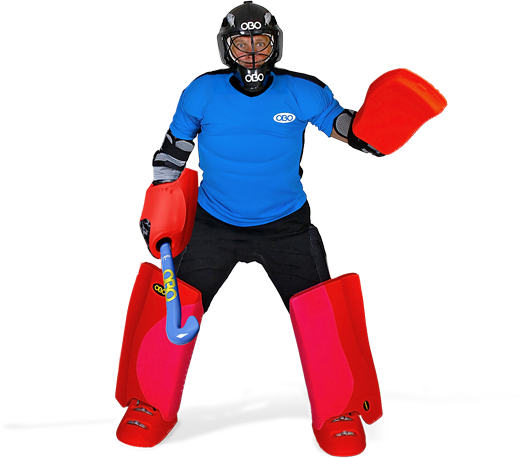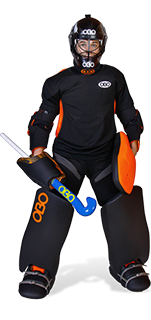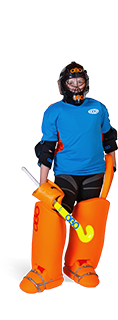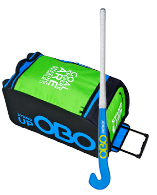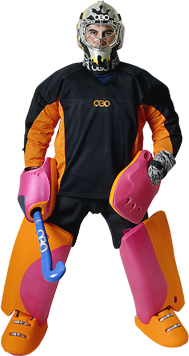KEEPERS RESOURCES

Hand-eye co-ordination
Hand-eye co-ordination is essentially related to how you watch shots into the save (how you “read” the shot and then appropriately react with the right save selection). It obviously helps you to make saves with your hands, as you watch the ball into your gloves! It is important to work on your skills to make sure that you can properly track the ball into glove saves. As it affects your ability to make the save, by being able to watch the ball and then move your glove in to stop the shot, you must regularly practise to improve.
Hand-eye co-ordination is a required part of your game: if you do not have the technique to see and stop the shot, how are you going to make saves to the sides with your hands, or block in front of your body? It is a simple fact that you need good hand-eye co-ordination to play at a high level in a game that revolves around speed and raised shots. Unlike soccer where the ball is larger and therefore easier to see, hockey obviously uses a smaller ball, so you’re going to have a tough time seeing the ball, especially through screens. By improving your hand-eye co-ordination, you can be able to stop shots more easily.
Bouncy ball
Bouncy balls are a great and fun way of practising your hand-eye co-ordination. They are really easy to get; you can buy them in corner shops, children’s toy shops, or sports shops. You can practise by throwing the ball hard onto the floor and then try to catch it; watching the ball take its unexpected bounce and into the catch. By doing this you have to use your eyes to watch the ball from its redirection, keeping up with the change of angle: this way, you are actively using your hand-eye co-ordination to make the catch.
“Wall ball”
Throwing a ball against the wall is a great and simple way of practising hand-eye co-ordination. The ball is thrown against the wall diagonally, bouncing off the angle to be caught at the other side.
You can vary the difficulty of the drill by making things harder for yourself to work that much harder. You can close your eyes when you throw the ball and then open them to make the catch. Because you cannot see where the ball is going (or on its initial throw), you have less knowledge as to where it’s going. Also, clapping in between a catch is another way. Try to make a clap between throwing and catching the ball to speed up your movements. By doing this, you can test your abilities even further; forcing your reactions to be faster.
Juggling
Juggling is a great way of learning to watch the shot into your equipment; watching the balls as you juggle. You have to maintain concentration throughout, watching the ball as it goes airborne, before catching it. You can start out with one or two, and then see how far you can progress. Juggling three balls in a row, or juggling two at the same time, are possible ways of challenging yourself to improve.
Keeping the ball up
A great drill that you can do when in pads at training or before a match is to do the equivalent of “keepy-uppies” with your glove and a spare hockey ball. You can do this by starting off kicking the ball up off your kickers (like a soccer player would do) or bouncing it off your gloves and stick. You can do this just before training or a game to help you focus on the ball. The idea is to keep the ball going and up for as long as possible. Try to keep it for as long as you can; the longer you can keep it up, the better your hand-eye co-ordination and focus on the ball will get.
Catching
Throwing and catching a ball in with someone else can help with your reading skills. You are having to watch the pass and then make the catch; working on your hand-eye co-ordination. With a partner, you can throw a tennis ball around between you, varying the speed and distance between yourselves to make it more difficult.
Other sports
Again, cross training in other sports can benefit your goalkeeping in hockey (playing other sports to work on your own skills within your chosen sport you want to focus on). Any sport that involves catching is great for working your hand-eye co-ordination. Playing in goal in soccer is a goalkeeping orientated way: in soccer, the goalie has to catch the ball to make a successful save, where you have to watch the ball into the catch. Racquet sports are good as you have to focus on the ball when serving and hitting; the ball can also take some unexpected bounces, making it harder; working on improving your hand-eye co-ordination.
Baseball (an American sport) is a good alternative: you have a glove that you need to watch the ball into to be able to make a good catch, as you throw the ball between you and a friend (this could also be done off a wall by yourself). To compare with another sport, Pekka Rinne is especially good right now in the NHL ice hockey league because of his ability to swallow up rebounds with a glove hand that acts much like a baseball catcher’s. Being the wicket keeper in cricket is a similarly good idea, as you have to watch the ball to be able to catch the batter out. Rugby or American Football could be other potential possibilities; you have to pass the ball around by throwing it and catching it; the odd shape of the ball makes it more difficult.
Comments
Leave Your Comments Below















